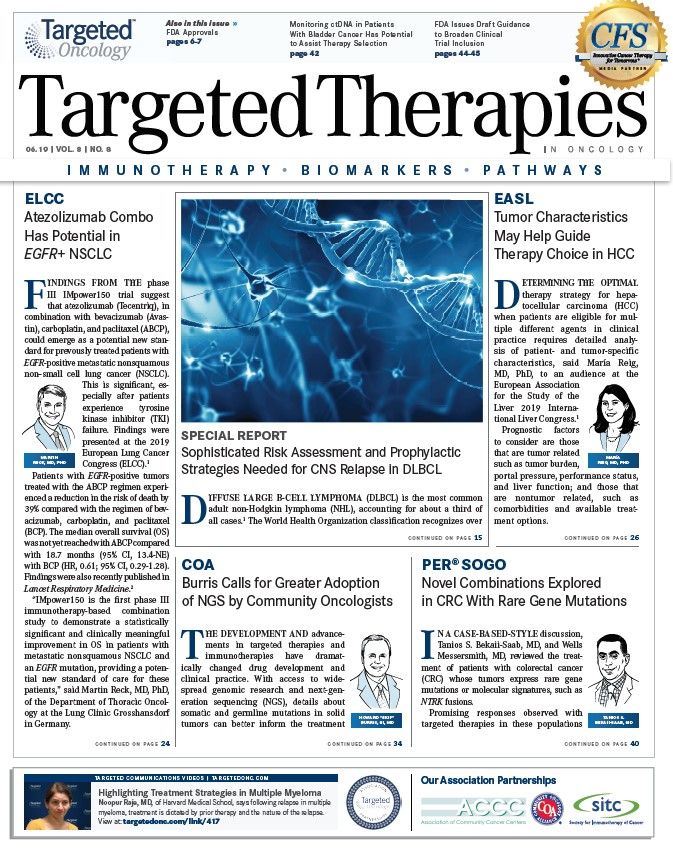Erdafitinib Approval in Urothelial Carcinoma Opens Door to Future Targeted Therapies
The recent approval of erdafitinib has significant implications for the field, says Arjun V. Balar, MD. It marks the most recent in a string of FDA approvals in urothelial carcinoma after nearly 3 decades of little to no advancement but is, importantly, the first targeted therapy in UC, which should open the door for more biomarker-driven drug discovery.
Arjun V. Balar, MD

Arjun V. Balar, MD
On April 12, 2019, the FDA approved erdafitinib (Balversa) for the treatment of patients with advanced urothelial carcinoma (UC) who have activating genomic alterations inFGFR2 andFGFR3 and progressed on prior platinum-containing chemotherapy and antiPD-1/L1 immunotherapy. Supporting this approval were data from the BLC2001 phase II study (NCT02365597) in 87 patients with advanced UC demon- strating a 32.2% response rate (2.3% complete response rate) and median duration of response of 5.4 months.
Erdafitinib is an orally administered inhibitor of FGFR1-3: although the approval of another targeted therapy in cancer is itself nothing new, the approval in UC marks the culmination of years of effort focused on developing therapies targeting this particular pathway.FGFRalterations in UC have been reasonably well described for years, and, importantly,FGFR3 has been a known driver present in 15% to 20% of high-grade invasive disease and appears to be particularly enriched in patients with high- grade upper tract tumors. Early trials either failed to reliably test for alterations, leading to ineffective patient enrichment and thereby underestimating a drug’s potential, or using entirely ineffective drugs.
The recent approval of erdafitinib has significant implications for the field. It marks the most recent in a string of FDA approvals in UC after nearly 3 decades of little to no advancement but is, importantly, the first targeted therapy in UC, which should open the door for more biomarker-driven drug discovery. Next-generation sequencing (NGS), which is necessary to identifyFGFRgenomic alterations required for erdafitinib use, will now be a standard of care in all patients with advanced UC. This will likely have many downstream effects, such as increased uptake of metastatic biopsies for NGS and other biomarker discovery platforms, which should lead to an improved and broader understanding of UC genetics and, hopefully, more therapeutic options.
In fact, several other competitor molecules target theFGFRpathway, with some subtle but important differences in development strategy. In particular, it appearsFGFRgene amplifications, even in the absence of a mutation, may be oncogenic drivers and thus responsive toFGFRinhibition. The development strategy for rogaratinib, also a pan-FGFR inhibitor currently in phase III testing, includes selectingFGFRgene amplifications in addition to mutations/gene fusions, which together may represent up to 40% of patients with advanced UC. Other agents that targetFGFRsignaling in UC include pemigatinib, infigratinib, and vofatamab. Each has subtle differences in development strategy, and these agents are being used either alone or in combination with other standard therapies. This flurry of “me too” activity in UC drug development is a welcome problem after decades of little progress because, as I tend to believe, competition in this setting stimulates an improved knowledge of biologic underpinnings, which should drive innovation and better drug discovery.

Peers Discuss Role of Pola-R-CHP vs R-CHOP in Newly Diagnosed DLBCL
April 19th 2024During a Case-Based Roundtable® event, Haifaa Abdulhaq, MD discussed with participants whether the POLARIX trial influences their choice to use the pola-R-CHP as opposed to R-CHOP regimen for patients with newly diagnosed diffuse large B-cell lymphoma.
Read More
Powell Reviews Updated IO/TKI Data and AE Management in Endometrial Cancer
April 18th 2024During a Case-Based Roundtable® event, Matthew A. Powell, MD, discussed the case of a patient with advanced endometrial cancer treated with lenvatinib plus pembrolizumab who experienced grade 2 treatment-related hypertension.
Read More